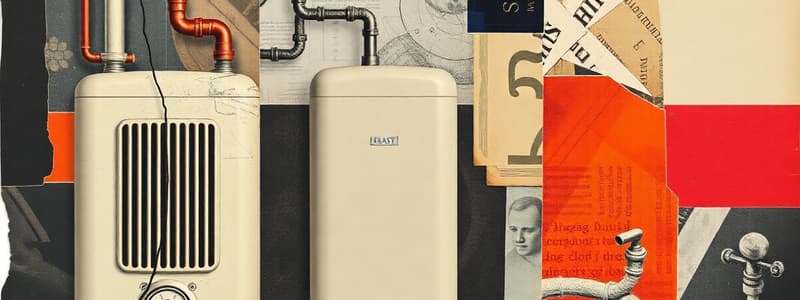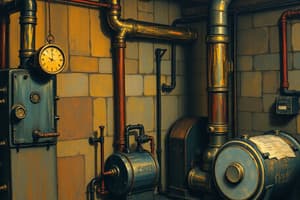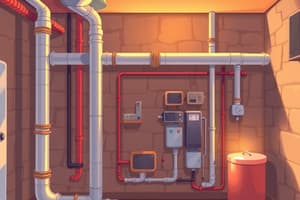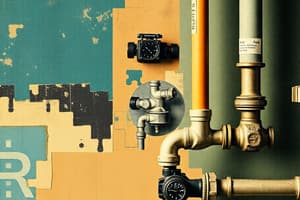Podcast
Questions and Answers
What is the primary goal of installing a central heating system in a domestic dwelling?
What is the primary goal of installing a central heating system in a domestic dwelling?
- To distribute heat evenly throughout the entire property. (correct)
- To serve as a backup for an existing heating system.
- To provide heat in a single room, similar to an open fire.
- To reduce the overall cost of home heating.
Which of the following standards relates to the design of water-based heating systems?
Which of the following standards relates to the design of water-based heating systems?
- BS EN 442
- Building Regulations Part L
- BS EN 14336
- BS EN 12828 (correct)
What defines a 'full central heating' system?
What defines a 'full central heating' system?
- A system that only heats selected rooms in a property.
- A system that uses a smaller boiler to reduce costs.
- A system that is primarily for background heating.
- A system that heats all rooms in a property to a set temperature. (correct)
What is a key difference between 'selective' and 'full' central heating systems?
What is a key difference between 'selective' and 'full' central heating systems?
What is the main purpose of 'background' central heating?
What is the main purpose of 'background' central heating?
What is a primary advantage of central heating compared to an open fire?
What is a primary advantage of central heating compared to an open fire?
What factor should a customer consider when selecting and using a central heating system?
What factor should a customer consider when selecting and using a central heating system?
What are the two main categories of modern domestic central heating systems, based on water supply and pressure?
What are the two main categories of modern domestic central heating systems, based on water supply and pressure?
How do low pressure, open vented central heating systems receive their water supply?
How do low pressure, open vented central heating systems receive their water supply?
What component is typically integrated into sealed, pressurized central heating systems to accommodate the expansion of heated water?
What component is typically integrated into sealed, pressurized central heating systems to accommodate the expansion of heated water?
Which of the following central heating systems is considered the oldest type?
Which of the following central heating systems is considered the oldest type?
What is a key characteristic of full gravity central heating systems?
What is a key characteristic of full gravity central heating systems?
Why is adding inhibitor to a full gravity heating system generally not possible?
Why is adding inhibitor to a full gravity heating system generally not possible?
In a one-pipe semi-gravity system, what is a primary disadvantage related to radiator temperature?
In a one-pipe semi-gravity system, what is a primary disadvantage related to radiator temperature?
What is a key benefit of a two-pipe semi-gravity central heating system?
What is a key benefit of a two-pipe semi-gravity central heating system?
In a two-pipe semi-gravity system, how is the circulation managed in the heating circuit as opposed to the hot water circuit?
In a two-pipe semi-gravity system, how is the circulation managed in the heating circuit as opposed to the hot water circuit?
How does a 'C plan' two-pipe semi-gravity system improve upon older two-pipe systems?
How does a 'C plan' two-pipe semi-gravity system improve upon older two-pipe systems?
What addition does a 'C plan plus' system have over a standard 'C plan' system, ensuring compliance with Building Regulations?
What addition does a 'C plan plus' system have over a standard 'C plan' system, ensuring compliance with Building Regulations?
What is the purpose of a 'heat sink' in a two-pipe semi-gravity system used with solid fuel boilers?
What is the purpose of a 'heat sink' in a two-pipe semi-gravity system used with solid fuel boilers?
What typically constitutes the 'heat sink' in a two-pipe semi-gravity system with solid fuel?
What typically constitutes the 'heat sink' in a two-pipe semi-gravity system with solid fuel?
What advantage do fully pumped systems offer over older heating systems?
What advantage do fully pumped systems offer over older heating systems?
What components typically control a fully pumped central heating system?
What components typically control a fully pumped central heating system?
What is a key feature of older pumped central heating systems, in terms of hot water provision?
What is a key feature of older pumped central heating systems, in terms of hot water provision?
In a fully pumped mid-position valve ('Y plan') system, what is the function of the three-port valve?
In a fully pumped mid-position valve ('Y plan') system, what is the function of the three-port valve?
What is the purpose of the automatic bypass valve in a fully pumped 'Y plan' system?
What is the purpose of the automatic bypass valve in a fully pumped 'Y plan' system?
In a fully pumped two, two-port valves ('S plan') system, what is each zone valve controlled by?
In a fully pumped two, two-port valves ('S plan') system, what is each zone valve controlled by?
In an 'S plan' system, if a property is over 150m², what additional component is typically installed?
In an 'S plan' system, if a property is over 150m², what additional component is typically installed?
Which of the following accurately describes 'locking out' in the context of a boiler?
Which of the following accurately describes 'locking out' in the context of a boiler?
What negative effect can aeration have on a central heating system?
What negative effect can aeration have on a central heating system?
What key component is absent from sealed systems compared to open vented systems?
What key component is absent from sealed systems compared to open vented systems?
What is the main purpose of a filling loop on a sealed central heating system?
What is the main purpose of a filling loop on a sealed central heating system?
What safety measure must be incorporated in the filling loop connection of a sealed system?
What safety measure must be incorporated in the filling loop connection of a sealed system?
What is the purpose of a pressure relief valve in a sealed central heating system?
What is the purpose of a pressure relief valve in a sealed central heating system?
Building Regulations part L covers what aspect of building design and construction?
Building Regulations part L covers what aspect of building design and construction?
According to Building Regulations, which part specifically addresses conservation of fuel and power in new dwellings?
According to Building Regulations, which part specifically addresses conservation of fuel and power in new dwellings?
CHESS is an acronym relating to central heating. What does it specify?
CHESS is an acronym relating to central heating. What does it specify?
Which system is more efficient: a one-pipe system or a two-pipe system?
Which system is more efficient: a one-pipe system or a two-pipe system?
What two things can aeration cause within a Central Heating System?
What two things can aeration cause within a Central Heating System?
If a central heating system struggles to achieve the desired comfort temperature at -1°C, how would it typically be categorized?
If a central heating system struggles to achieve the desired comfort temperature at -1°C, how would it typically be categorized?
What is the main operational difference between a standard two-pipe semi-gravity system and a 'C plan' two-pipe semi-gravity system?
What is the main operational difference between a standard two-pipe semi-gravity system and a 'C plan' two-pipe semi-gravity system?
In a fully pumped mid-position valve ('Y plan') system, what is the primary reason for including an automatic bypass valve?
In a fully pumped mid-position valve ('Y plan') system, what is the primary reason for including an automatic bypass valve?
In a domestic central heating system, under what circumstance would an additional heating zone valve typically be installed in an 'S plan' (fully pumped two, two-port valves) system?
In a domestic central heating system, under what circumstance would an additional heating zone valve typically be installed in an 'S plan' (fully pumped two, two-port valves) system?
Why is it essential to disconnect the filling loop after charging a sealed central heating system to the correct pressure?
Why is it essential to disconnect the filling loop after charging a sealed central heating system to the correct pressure?
Flashcards
Purpose of central heating?
Purpose of central heating?
To provide thermal comfort within a property by heating every room.
What is Full Central Heating?
What is Full Central Heating?
All rooms are heated simultaneously to a specific temperature.
What is Selective Central Heating?
What is Selective Central Heating?
Only selected rooms are heated to a specific temperature.
What is Background Central Heating?
What is Background Central Heating?
Signup and view all the flashcards
How do Gravity Systems work?
How do Gravity Systems work?
Signup and view all the flashcards
What is a Gravity or Semi-Gravity System?
What is a Gravity or Semi-Gravity System?
Signup and view all the flashcards
What are Full Gravity Systems?
What are Full Gravity Systems?
Signup and view all the flashcards
What is a One Pipe Semi-Gravity System?
What is a One Pipe Semi-Gravity System?
Signup and view all the flashcards
What is the Two Pipe Semi Gravity?
What is the Two Pipe Semi Gravity?
Signup and view all the flashcards
What is C Plan two pipe semi gravity
What is C Plan two pipe semi gravity
Signup and view all the flashcards
Two pipe semi gravity with heat sink
Two pipe semi gravity with heat sink
Signup and view all the flashcards
What are Fully Pumped Systems?
What are Fully Pumped Systems?
Signup and view all the flashcards
Pumped central heating
Pumped central heating
Signup and view all the flashcards
Fully pumped mid-position valve
Fully pumped mid-position valve
Signup and view all the flashcards
Fully pumped two, two port valves
Fully pumped two, two port valves
Signup and view all the flashcards
Locking out
Locking out
Signup and view all the flashcards
Aeration
Aeration
Signup and view all the flashcards
Sealed system
Sealed system
Signup and view all the flashcards
Building Regulations: Part L?
Building Regulations: Part L?
Signup and view all the flashcards
Sealed, pressurized systems
Sealed, pressurized systems
Signup and view all the flashcards
Study Notes
- Domestic central heating systems are installed in domestic dwellings.
- Learners will study old and new central heating systems.
- Learners will look at components that make up systems.
- Learners will be able to describe the type of system at home.
- Central heating is needed, and it is important to understand what gives us heat in homes.
- It is important to make sure the customer understands how to work their central heating.
Legislation
- Building Regulations part L: Conservation of fuel and power.
- BS EN 12828: Design of water based heating systems.
- BS EN 14336: Installation and commissioning of water based heating systems.
- BS EN 442: Manufacture of radiators.
- CHESS: Central Heating Efficiency System Specification (basic and best practice).
- Building Regulations part L covers:
- L1a: New dwellings.
- L1b: Existing dwellings.
- L2a: New, other than dwellings.
- L2b: Existing, other than dwellings.
Types of Systems
- The main purpose of central heating is to provide thermal comfort within a property.
- An open fire gives heat in one room, but central heating can give heat in every room.
- Thermal comfort exists when the desired heat balance between the body and surroundings is met within the customer's economic constraints.
Full Central Heating
- All rooms in a property are heated simultaneously to a specific temperature set by the customer.
- This comfort temperature must be reached, even when the outside temperature is -1°C.
Selective Central Heating
- Some rooms in a property are heated simultaneously to a specific temperature set by the customer.
- The customer selects which rooms are heated.
- This comfort temperature must be reached, even when the outside temperature is -1°C.
Background Central Heating
- Can be the same as full or selective, but it is installed mainly on cost basis.
- A smaller boiler or heat emitters may be used, which will only take the chill out of rooms.
- If a system cannot achieve the customer's desired comfort temperature when the outside temperature is -1°C, the system would be classed as background heating.
- Over the past 100 years, the open fire in each room has been developed and replaced with:
- Gravity hot water system
- Pumped heating with gravity hot water
- Fully pumped system
- Central heating is now preferred to an open fire, as it heats up the whole property.
- Solid fuel has been replaced with gas, oil, and electricity to heat the system.
- Customers will be cost conscious, not only at the point of installation, but also with running costs.
- Running costs include maintenance, efficiency, performance, and controls.
- Modern domestic central heating systems fall into two categories: low pressure open vented systems and sealed pressurized systems.
Low Pressure, Open Vented Systems
- Fed from a feed and expansion cistern located at a high level.
- Can be fully pumped or gravity systems.
Sealed, Pressurized Systems
- Fed directly from the mains cold water and incorporate an expansion vessel to take up the expansion of the heated water.
- This system is a more modern fully pumped or combination boiler system.
Central Heating System Types
- Wet central heating systems include open-vented (low pressure) systems and sealed (pressurized) systems.
- Open-vented (Low pressure) systems include:
- Semi-gravity systems
- Pumped heating only systems
- Fully pumped systems
- Sealed (pressurized) systems include the following components
- System boiler option
- Semi-gravity systems include:
- One-pipe systems
- Two-pipe systems
- Pumped heating only systems use a system with two two-port motorized valves.
- Fully pumped systems include:
- System using one three-port mid position valve
- C-Plan system
- System boiler options include:
- Systems using external expansion vessel
- Combination boiler systems
Gravity or Semi Gravity Systems
- Older systems use convection currents to circulate water around the pipework.
- Usually have 28mm primaries associated with solid fuel boilers and the need for convection currents.
- Gravity or semi-gravity systems include:
- One pipe semi gravity
- Two pipe semi gravity
- C plan semi gravity
- C plan plus semi gravity system
- Two pipe semi gravity with heat sink
Full Gravity Systems
- These systems are no longer installed but you may come across them in older properties.
- Systems offer background heating and use large diameter pipework that has to be laid at the correct fall to allow convection to work properly.
- No pump exists in the system for either hot water or heating, so the heat-up time was lengthy.
- Systems are old and rarely seen but still in use in some older houses, that are single feed or primatic hot water cylinders.
- There is no F&E to fill the primary circuit; done via the cold feed to the cylinder.
- No inhibitor can be added to this type of heating system.
- It is a gravity only system and cannot be converted to pumped, or the air lock separating the two waters will be lost.
One Pipe Semi-Gravity System
- Older, simpler system includes a one-pipe circuit going from and returning to the boiler.
- The circuit would be pumped, but the flow and return stems to each radiator relied on gravity to heat them up.
- Installation cost was cheaper due to only one ring pipe being installed.
- Drawback: As the return water from each heat emitter entered the main ring, it would cool the flow water down to the following emitter; progressively each radiator was cooler than the one before.
One Pipe Gravity System
- Advantages:
- Cheap to install.
- Disadvantages:
- Each radiator progressively cools down
- Only the main ring is pumped
- Uncontrolled room temperature
- Boiler could cycle
- Not compliant to Building Regulations part L
- Boilers connected to these systems are low efficiency
Two Pipe Semi Gravity
- The system has gravity circulation to the hot water circuit but pumped circulation to the heating circuit.
- Separate pipes for the flow and return, water was forced into the heat emitters, and the flow and return waters did not mix.
- Allows the heat emitters to achieve the same temperature.
- Control on the heating was sometimes by a room stat, which only switched off the pump.
- The hot water had no such control and was often very hot.
- Advantages:
- All heat emitters reach the same temperature.
- Two pipe system is quicker when heating up.
- Cheaper to run.
- Disadvantages:
- Uncontrolled heat.
- Boiler cycling.
- Not compliant to Building Regulations part L.
- Boilers connected to these systems are low efficiency.
C Plan Two Pipe Semi Gravity
- An updated version of a two pipe semi gravity system that includes a cylinder thermostat and zone control on the hot water.
- The C plan plus includes a room thermostat, TRVs and zone control on the heating, as well as controls on the hot water.
- The C plan plus is the minimum acceptable compliant system with Building Regulations part L16 and the Domestic Heating Compliance Guide, which states the system has to incorporate a thermo mechanical thermostat.
- Advantages:
- All heat emitters reach the same temperature.
- Two pipe system is quicker to heat up.
- Compliant to Building Regulations L16.
- Full control on heating and hot water.
- Disadvantages:
- Not fully pumped.
- Boilers fitted to this system tend to be lower efficiency.
Two Pipe Semi Gravity With Heat Sink
- Used with solid fuels, which are not as controllable as gas or oil boilers.
- If gravity circulation stops due to the flow and return being the same temperature, the boiler is still producing heat.
- The heat sink can dissipate this without the boiler overheating.
- The heat sink is generally a radiator with two lock shield valves.
- The boiler thermostat on a solid fuel boiler is often as simple as an air damper, rather than an electrical control.
- Advantages:
- Compliant with Building Regulations part L.
- Disadvantages:
- Restricted heat control.
- Only used on open vented systems.
- Overheating possible.
- Can be expensive.
Fully Pumped Systems
- The modern systems use a pump to circulate the heated water around the hot water and heating circuits.
- This is controlled by installing a cylinder thermostat, room thermostat and programmer, along with either two zone valves or a three port mid-position valve.
- These systems offer better control, design and boiler type.
- The boiler position no longer needs to be lower than the cylinder.
- Heat-up times are much quicker, so the system is more economical on fuel and operating costs.
- Boilers can be fueled from natural gas, LPG or oil.
Pumped Central Heating
- Older type systems do not have any provision for hot water but serve some heat emitters around the property.
- The cold feed and vent pipe can be taken from the boiler (four tapping boiler) or from the pipework.
- It is generally a two pipe system with a circulator to assist the heat-up time.
- The controls consist of a timer, boiler thermostat and possibly a room thermostat, heating all rooms to a controlled, comfortable temperature.
Fully Pumped Mid-Position Valve – Y Plan System
- The three port mid-position valve controls the flow of water to the hot water cylinder and heating circuit.
- The valve reacts tothe room thermostat and cylinder thermostat.
- Has an automatic bypass valve, which connects to the flow and return pipe.
- The bypass opens if the system pressure increases when circuits close down due to them reaching temperature.
- Allows water to flow through the boiler, stopping lock out, and it also prolongs the circulator life.
Fully Pumped Two, Two Port Valves – S Plan System
- This system uses one zone valve to control the hot water, which is activated by the cylinder thermostat, and a second zone valve, which is activated by the room thermostat.
- The zone valve acts as an isolator, closing the flow of water off.
- If a property is over 150m², an additional heating zone valve should be fitted, allowing independent control of upstairs and downstairs.
- As with the Y plan, an automatic bypass is fitted to the system.
Y Plan vs S Plan
- Y plan and S plan both offer full thermostatic control and building regulations compliance.
- S plan is recommended for larger properties, and it has boiler interlock.
- Y plan and S plan can both be used with sealed systems, system boilers, and zonal systems.
Locking Out
- A protection system within a boiler.
- A thermostat shuts the boiler down if it detects the flow is above 85°C and therefore stops it from overheating.
Aeration
- A big cause of corrosion within a central heating system.
- Air plus iron equals rust: rust is iron oxide that produces magnatite, which is the black sludge.
- Aeration also causes system noise and can burn the circulator out.
Sealed System
- A system is not open to atmosphere and incorporates a sealed expansion vessel, which replaces the feed and expansion cistern of the open system.
- A filling connection needs to be installed, along with a detachable filling loop.
- Allows a point at which the system can be filled under mains pressure.
- A double check valve needs to be installed, to prevent the possibility of back siphonage of central heating water into mains water.
- On both of the filling loop connections, a means of isolation needs to be fitted.
- Water Regulations state that this loop needs to be disconnected after the system has been charged to the correct pressure.
- A pressure relief valve will need to be installed to discharge pressure to a safe location if required.
Studying That Suits You
Use AI to generate personalized quizzes and flashcards to suit your learning preferences.




